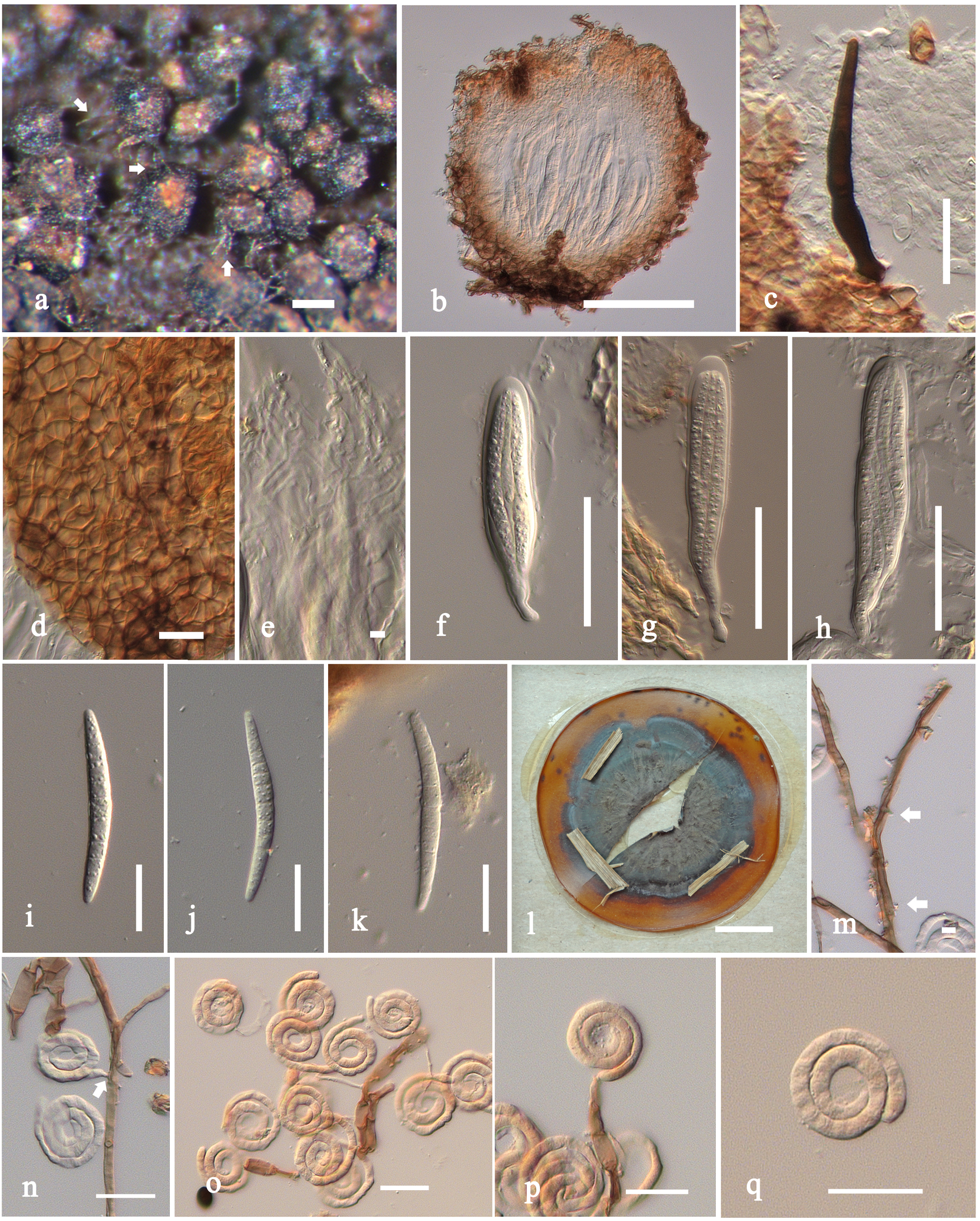Helicoma rugosa (C. Booth) S. Boonmee & K.D. Hyde, comb. nov.
≡ Tubeufia rugosa C. Booth, Mycol. Pap.94: 13 (1964)
≡Thaxteriella helicoma (W. Phillips & Plowr.) J.L. Crane, Shearer & M.E. Barr, Can. J. Bot.76(4): 610 (1998)
= Sphaeria helicoma W. Phillips & Plowr., Grevillea, 6:26 (1877)
Saprobic on leafy substrata. Sexual state: Ascomata (242-)303–340 µm high ´ (218-)238–263(-331) µm diam., superficial, solitary, sometimes clustered, gregarious, subglobose, oval to obovoid, with soft texture, dark brown, pale brown above, with a central papillate ostiole, with rare setae. Setae 61–80 µm long, dark brown, tapering towards subacute apex, widest at base, septate. Peridium 39–44 µm wide, composed ofbrown to reddish-brown cells of texturaangularis. Hamathecium comprising numerous, 1–2 µm wide, filiform, septate, branched, hyaline pseudoparaphyses. Asci (90-)96–135 ´ 15–20 µm ( = 112 × 19 µm, n = 20), 8-spored, bitunicate, elongate to cylindric-clavate, thickened at apex, with (7-)20–31.5 µm long pedicels, ocular chamber not observed. Ascospores 42–61 ´ 5–8.5 µm ( = 53 × 6 µm, n = 20), 2–3-seriate, elongate-fusiform, subcylindrical, tapering towards subacute ends, (8-)9–10-septate, not constricted at septum, hyaline, smooth-walled. Asexual state: hyphomycetous, helicosporous. Conidiophoresmacronematous, thick-walled, septate, branched, brown to moderately brown. Conidiogenous cells monoblastic to polyblastic, terminal or intercalary, dentate, brown to dark brown, darkened at basal septum. Conidia(17-)22–28 µm diam., conidial filaments 4–5 µm wide ( = 24 × 5 µm, n = 20), helicoid,tightly coiled 2–3½ times, hyaline to pale brown, tapering toward flattened end and scar, multiseptate, not constricted at septum, smooth-walled.
Cultural characteristics (based on dried culture):Colonies dark brown, superficial and partly immersed in mycelium, with dark brown, septate, branched hyphae.
Material examined: BERMUDA, Devonshire Marsh, Devonshire Parish, on leaves of Sabal bermudianaL.H. Bailey (Arecaceae), coll. R.P. Korf and A.Y. Rossman (AR-BER 12), on 18 January 1980;det.A.Y. Rossman (BPI 1104599, dried culture: BER 12 80–4).
Notes: Helicoma rugosa based on Tubeufia rugosa C. Booth was originally described as Sphaeria helicoma W. Phillips & Plowr. (1877). Pirozynski (1972) redescribed and transferred the fungus to Tubeufia based on that helicosporium asexual morph. Subsequently, Crane et al. (1998) transferred it to Thaxteriella because of the pigmented ascomata and peridial wall structure. In addition, Thaxteriella helicoma also produced a helicoid asexual state in culture (Fig. 15). According to molecular analysis (Clade A, Fig. 2), the putative isolates of Thaxteriella helicoma(JCM 2739 and UBC F13877) cluster in Helicoma sensu stricto, while the strain from UBC F13877 clustered with the generic type species Helicomamuelleri CBS 964.69 with strong support (100% BS and 1.00 PP). The placement of Helicoma rugosa in Helicoma is well-supported by morphology and molecular phylogeny. Although Sphaeria helicoma is an older name it cannot be used to represent this species as it would result in a tautonym; the name of a genus and species that are the same are not allowed in botanical nomenclature. Therefore we used the next available synonym which is Helicoma rugosa.
Fig. 1 Helicoma rugosa (BPI 1104599, dried culture: BER 12 80–4). a Ascomata. b L.S. ascoma. c Single seta. d Peridial wall. e Pseudoparaphyses. f-h Asci. i-k Ascospores. l Colony on dried culture. m Mycelium. n Conidiophore (arrows). o-q Conidiophores with attached conidia. Scale bars: a-c=100µm, c-d, i-k, n-q=20µm, f-h=50µm, e, m=5µm, l=1cm

